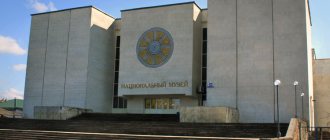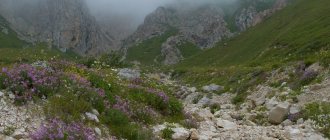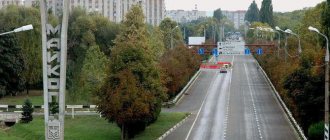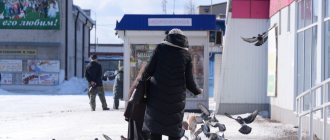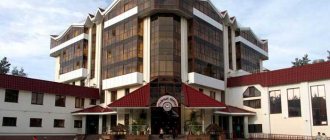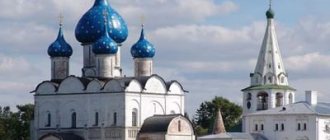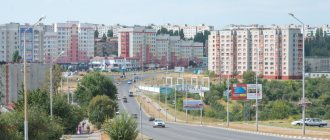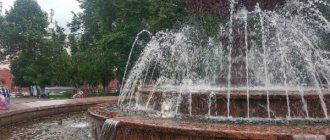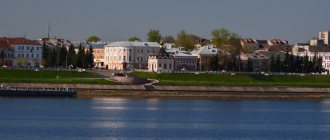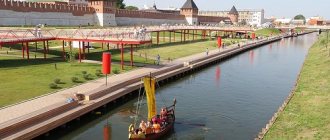Lighthouse
Photo: Yandex map
It has developed transport links. There are almost no new houses here; for the most part, real estate is represented by five-story buildings and the private sector. There are plenty of preschool institutions, as well as cafes and shops, but there is almost no place for children to go out - if there are playgrounds, they are in unusable condition. To purchase an apartment you will need at least 2.35 million rubles.
Maykop how to get there
Where the city of Maykop is located will be easy to find; it will be difficult to miss the capital of Adygea. The city is surrounded by greenery and flowers until autumn. You should like it here; it’s useful to spend your holidays in a new place every year.
You will see new places, people, sights. Adventures allow you to escape from routine and gain new experiences. You can get to the city by plane, bus, train or car.
They say that there is an airport in Maykop itself. Actually this is not true. And if you are thinking of flying on vacation by plane, then buy a ticket to Krasnodar. From there to Maykop the drive is about 123 kilometers. You can take a taxi, go by train or bus. Will you be traveling in your own car? Focus on Krasnodar and plan your route in advance. Along the streets and through villages you can shorten a significant part of the route.
There is a train from major cities of the country to Maykop. Almost all flights in the direction of Adler go here; you need to get off at Belorechenskaya station. Then you can get there by taxi or bus. You will find where the city of Maykop is located quite quickly, so the journey will be more pleasant than tiring.
You may be interested in other articles that describe the Krasnodar Region , including the little-known village of Veselovka , the village of Kholmskaya and vice versa visited by Abrau Durso , as well as many others.
Center
Photo: Yandex map
Five-story houses from the 60s predominate here; sometimes there are two-story ones. There is a central park and Friendship Square, where city festivals are held. There are also fountains and green alleys. The infrastructure is represented by a large market and a train station. In addition, all social organizations are gathered in the central part. Shopping lovers will appreciate the large concentration of shops and brand boutiques. The cost of an apartment starts from 2.5 million rubles.
Attractions in the vicinity of Maykop
After exploring the city's attractions, spend the remaining time traveling outside the city, where there are stunning creations created by man and nature.
Meot Fortress
Near the canyon of the Khadzhok Gorge, located in the vicinity of Maykop, stands the ancient fortress of Meot. From the fortress walls and roof it is a pleasure to admire the view of the Unakoz mountain range, Krasnaya Lake and the floodplain of the Belaya River.
St. Michael's Monastery
Near the village of Pobeda near Mount Fiziabgo, the white-stone monastery of St. Michael delightfully fits into the natural landscape. It houses the Holy Trinity Church and a unique underground chapel, where the inhabitants of the monastery and many pilgrims spend their days in prayer. Tourists are allowed to go down into the dungeon, where they can see the chapel and underground cells. In this blessed place, a healing spring flows, filling a person with health and vitality.
In addition to architectural monuments, you will be amazed by the picturesque Lagonaki plateau, the mystery of the ancient underground grottoes and stone halls of the Big Azish Cave, the beauty of Mount Fisht with underground caves and the flora and fauna of the Caucasian Biosphere Reserve. The sights seen in Maykop and its surroundings will more than once evoke pleasant memories and a desire to return again to the paradise “Valley of Apples”.
Sunrise
Photo: Yandex map
Located in the eastern part of the city and is considered a residential area. The real estate is represented by houses from the 70s, mostly five-story buildings, where apartments are valued at 1.9 million rubles. This area has everything you need for life: schools and kindergartens, cafes and shops. Distance from the center can be solved using personal or public transport, which does not pose any difficulties.
Maykop: old town
December 3–4, 2013
I divided that part of the Adyghe capital that I had the opportunity to explore into two halves: old and new. This division is conditional, the locals do not use it, but Maykop is demarcated quite clearly: if the streets lying north of Sovetskaya are much closer in appearance to the Soviet city, then in the southern half of the city historical buildings with several very interesting buildings prevail. There is also a pedestrian street here, so that’s where we’ll start.
The first street you should pay attention to is Pushkina. Its appearance is quite typical: a dense southern one-story building.
There are interesting buildings in it, but sometimes finding them is not so easy. For example, a Roman Catholic church is hidden in this inconspicuous Soviet box. The church was built in 1914, but under the Bolsheviks it was converted into gyms and changed beyond recognition.
On the internet you can find what the church looked like before, but in reality only the roof and a small piece of the old façade sticking out above the socialist walls remained available for viewing.
The neighbors of the church are diverse. There is also an abandoned Soviet building with a powerful portico...
...and a nice, newly built building of the Adyghe State University...
...and another beautiful pre-revolutionary building, a real school building (1900). Now it houses a school.
After the revolution, the eastern wing was added to it, so it looks asymmetrical: on the right we see beautiful masonry and semicircular windows, and on the left there is a dull birdhouse. In addition, the “architects” managed to cram an extra floor into the same height of the building.
Nearby there is a small monument to Lenin, not the most important one in the city.
Ilyich looks at the beer territory class=”aligncenter” width=”1080″ height=”720″[/img]
They say that they used to brew excellent beer here, but after the reorganization in the mid-2000s, the quality deteriorated.
But the new owners reconstructed the main workshop of the plant. This building was built in 1882, and the history of Maikop brewing began with it.
Judging, again, from old images, it was restored very well, and a hotel was opened in one of the expanded side wings. Unexpectedly expensive and good.
The Republican Clinical Hospital was apparently also recently renovated.
Wide sidewalk of Pushkin Street.
The street is named after the poet, obviously, because of the Pushkin People's House built here in 1900. In 1936, the Russian Drama Theater was formed there, also bearing the name of the poet. The building was seriously damaged during the war, so after restoration, instead of a pair of turrets, it received a more typical appearance for the Stalin era, and at the same time a bust of Pushkin in front of the entrance.
Immediately after the theater, the City Park begins.
The park is clean and pleasantly well-groomed: tiles, benches, trimmed greenery. There are also attractions and a couple of statues with local historical figures.
Well, in the center there is a light and music fountain. Of course, I didn’t work in December.
The fountain stands on the edge of the valley, and below flows the small White River (not to be confused with the Ufa Teska), barely visible under the pedestrian bridge. The empty space in the foreground with a pillar in the middle is a public swimming pool. I swam and went to the park. Cool?
Even further to the left is the dam and spillway of the Maykop hydroelectric power station. In comparison with the small Mainskaya hydroelectric station I had seen before, the Maikopskaya hydroelectric station is very small and unproductive (9.44 megawatts versus 321). But it’s worth considering that she is thirty years older (1950), and Belaya is far from Yenisei. Overhanging the dam is Tsarskaya Hill, just over 300 meters high.
We return to Pushkin Street to find another piece of the old brewery - a magnificent malting shop (1900s).
I also like the more typical industrial architecture of the early 20th century, but here it’s a real treat to the eye: every brick is in its place. This is the most beautiful building in the whole city.
Judging by its appearance, it is used, but I don’t know in what capacity. There is parking in the backyard.
We have already turned onto Lenin Street, going north. Here it is poor in attractions and generally does not fit into the main street of the city. In addition to a couple of mansions that were included in the previous part of the story, the only thing that can be noted is the new building of the Investigative Committee. Nice classic shape, just needs some plastering.
If you turn from Lenin onto Komsomolskaya, you can find a nice Stalinist building...
...and the building of the primary school (1910), which now trains medical workers (you can see them in the window). A very typical house for Maykop.
Pervomaiskaya Street, which runs parallel to Pushkin, looks much more interesting. In its western part there is the North Caucasus branch of the Museum of Oriental Art. It opened in 1995; the building is also based on a house built in the early 20th century (the façade on the left appears to be original).
Even further, in another beautiful brick building (1883), the first post office of Maykop was once located. The same building is shown in the title photo.
Today it houses a lyceum, which has acquired a new building.
The urban part of Maykop ends approximately here (in the “horizontal” direction). All beauty becomes one-story.
And then it will be replaced by the typical private sector.
(If you walk long enough in a western direction, you can stumble upon the Holy Trinity Cathedral. I saw it the day before the walk from the car window - I wasn’t impressed, so I didn’t go see it a second time.)
Southern cities have their own, very recognizable comfort. There's a lot of it here.
Let's go back a couple of blocks, to the city part. Here Pervomaiskaya has a completely different look.
But first I’ll show you the Maykop pedestrian. It is called Krasnooktyabrskaya Street (yes, all the names here are Soviet) and starts from the city park. The street owes its first name to him - it was once called Sadovaya.
In the first block of the street, two buildings can be noted. Mayor Ivanov, who was in charge of Maykop in the 1900s, lived in this mansion:
On the contrary, in 1908, a building was built that housed, as in neighboring Krasnodar, a cinema (“electrobiograph”) and a roller skating ring. This establishment was called “Pantheon”, and it received its modern name “Giant” in 1921. Now officially this is the City House of Culture, although films are still shown under the old sign.
Near the cinema there is a nice monument to the local writer Kerashev.
At the intersection with Pervomaiskaya there are three interesting houses (this is generally the most expressive intersection of Maykop). The house of another mayor, Zinkovetsky (or Zinkovetsky, wherever) built in 1907, is occupied by the House of Officers.
Across the road is beautiful early Soviet housing.
And on the other side of Pervomaiskaya there is the Kaplanov trading house (1900). From here the street becomes a carriageway.
This family also had an apartment building here. It was built in 1912, when Sadovaya was already called Ofitserskaya (having managed to visit Telegraphnaya in the meantime).
The building has been rebuilt many times and already looks a lot like the Stalinist building opposite.
The Maikop Hotel is located in the income area. The rest of the street development is visible in the photo and is not of particular interest. Not bad for three blocks, though.
On Krasnooktyabrskaya, as it should be on a pedestrian street, there are several cafes and restaurants. In general, the street is no frills, but quite neat and pleasant.
We head further east along Pervomaiskaya past the city court...
...to another notable old building - the former Altshuler pharmacy (1889).
There is a retail store attached to the side. I didn’t find any information, maybe it’s a remake.
Further blocks are occupied by students: here are the Maykop State Technological...
...and the already mentioned Adyghe State University.
Between them stands a fire tower (1900).
And then the one-story building begins again. Thus, we crossed the multi-storey center of Maykop from east to west and back: its length was about a kilometer.
In the direction from north to south, “urban” Maykop is a little larger - about two and a half kilometers. A quarter of the distance is covered in this report.
The rest, newer part of Maykop will be covered next.
Whole series:
Part 1: introduction → Part 2: old city Part 3: new city

